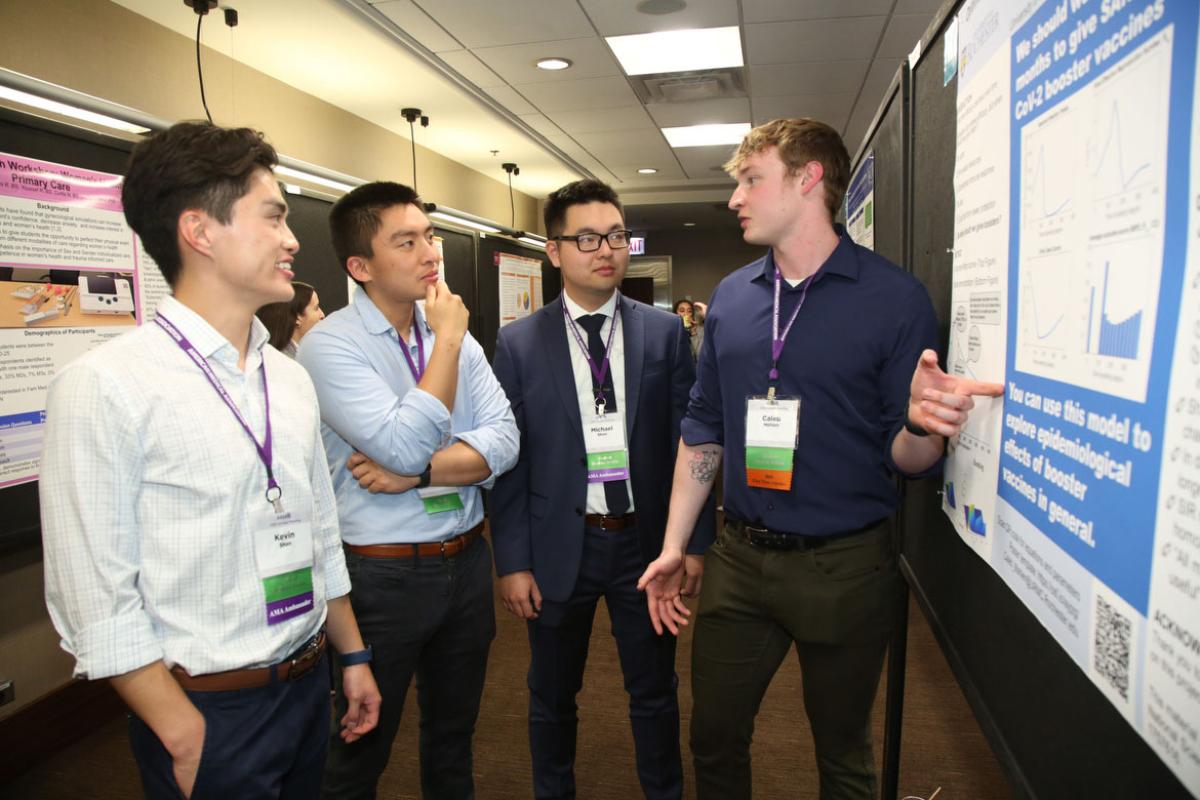As a medical student, do you ever wonder what it’s like to specialize in family medicine? Meet Sumi Makkar Sexton, MD, a family medicine specialist and a featured physician in the AMA’s “Shadow Me” Specialty Series, which offers advice directly from physicians about life in their specialties. Check out her insights to help determine whether a career in family medicine might be a good fit for you.
The AMA’s Specialty Guide simplifies medical students’ specialty selection process, highlights major specialties, details training information, and provides access to related association information. It is produced by FREIDA™, the AMA Residency & Fellowship Database®.
Learn more with the AMA about the medical specialty of family medicine.
“Shadowing” Dr. Sexton
Specialty: Family medicine.
Practice setting: Group practice.
Employment type: Private practice.
Years in practice: 21.
A typical day and week in my practice: My days vary, which is one thing that keeps me going. Monotony bores me, and I thrive on different schedules, patient encounters, work settings, and then finally settling into family time and social events. It is all about balance to me—embracing changes and challenges but setting boundaries when needed to reduce burnout.
On Mondays, Tuesdays, and Fridays, I see patients in the morning at a private family practice managed by me and two awesome women partners. I usually have a medical student working with me, so we prep charts in the morning and then off we go. The first part of most afternoons is spent catching up on charting and clinical tasks, which has been reduced somewhat thanks to having a virtual scribe.
After that I transition into academic mode which includes a combination of catching up on emails regarding the American Family Physician journal (I am the editor in chief), editing or writing an article, and mentoring a fellow or resident in medical editing. Luckily, I have Wednesdays all day and Thursday mornings to continue this work, schedule journal meetings, and sometimes teach a small group at Georgetown University.
Thursday afternoons, I am back in the office to see patients. Evening hours are sometimes spent tying up loose ends related to patient care and editing or attending meetings for my medical group to discuss quality measures and population health. Sometimes the day ends at 5 p.m. (especially if I need to be at a school event for my teenage children), but it could be as late as 8 p.m. depending on my meeting schedule.
Unless I am on call, I don’t have much clinical work on the weekends, but I do often spend at least a few hours in my editing world. I don’t see patients in the hospital anymore (only social visits), as we decided several years ago that it was difficult to manage our patient volume in the office and then go to the hospital, especially as working moms. I see it as my job to keep my patients out of the hospital, so when I am on call, I will often schedule virtual visits to keep our patients from having to go to urgent care or the emergency department.
The most challenging and rewarding aspects of family medicine: Sometimes you feel that everything falls on your shoulders. Even if I am not the one managing my patient in the hospital or performing their surgery, if something goes wrong or any forms are needed, I feel obligated to help. If they can’t reach their specialist for a problem or even if they can, who do they reach out to? Me. I am proud that my patients trust me, but it can be overwhelming. Family physicians—all primary care physicians—are the stopgap and beyond.
The most rewarding aspect of family medicine ties into the challenges, and it is the ongoing trust and bond that I have created with patients and their families. It is the reason I get up to go to work, and the reason that all the hectic days are still worth it. My patients have taught me so much over the years, and we’ve seen each other mature and adapt over time.
Another rewarding aspect is the scope of practice I was trained in and able to practice over the years. I never get bored because my day is filled with patients of all ages including elderly ones, babies and lots of teens (I love babies and teens), and a variety of procedures ranging from colposcopy to ear piercing to skin biopsies (I love procedures).
Three adjectives to describe the typical family medicine doctor: Dedicated, down-to-earth/the real deal, and adaptable.
How my lifestyle matches, or differs from, what I had envisioned: Overall, family medicine is exactly what I expected. It has allowed me the flexibility to create my own career.
My path unexpectedly led to opening a private practice, but I had opportunities to do community health, urgent care, hospital medicine and academic medicine. I have felt well-trained to see patients of all ages and offer a variety of treatments. If I had chosen to do international health, I would have felt prepared to do so.
In doing family medicine, I’ve been able to balance a fulfilling career in helping patients with having a loving family. It’s not a perfect balance and requires give and take, but this struggle applies to all fields of medicine and many other types of careers.
Skills every physician in training should have for family medicine but won’t be tested for on the board exam: Like all physicians in training, family medicine residents need to be self-directed learners driven to master the scope of the specialty. In addition, we really need family physicians to be flexible, optimistic and empathetic.
A day in clinic or in the hospital could bring well-child exams, maternity care, chronic disease management involving multiple organ systems, or end-of-life care. Family physicians need to be flexible and adaptive to whatever waits on the other side of the door, optimistic that they can make a positive difference, and empathetic to patients and themselves when challenges arise.
One question physicians in training should ask themselves before pursuing family medicine: Do you enjoy caring for patients of all ages, establishing continuous relationships with patients and their families, challenging yourself to broadly increase your fund of knowledge, and practicing a variety of procedures in an outpatient setting? If so, then family medicine is for you!
The good news is that even if you like only some of those things, family medicine offers niche practice styles too, such as sports medicine, geriatrics, addiction medicine and women’s health. But if you prefer a specific age group and more narrow scope of practice or only want to be in the hospital setting, then there are probably other specialties that are a good fit.
Books every medical student interested in family medicine should be reading: I am a big podcast fan, so here is one I highly recommend: the “American Family Physician Podcast.”
The online resource students interested in family medicine should follow: The American Academy of Family Physicians medical students page.
Mantra to describe life in family medicine: The principles of family medicine are caring for all, caring with continuity, and caring comprehensively. We guide patients through challenges and choices. We are family medicine, and this is what we do.



